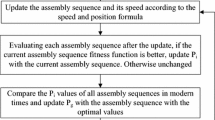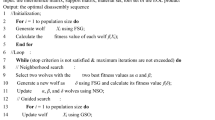Abstract
To improve the efficiency of complex assemblies in large-scale assembly sequence planning, an intelligent sequence planning method for constructing an assembly hybrid G-diagram model to realize the hierarchy of assembly structures is proposed. The assembly hybrid G-diagram model is constructed according to the assembly relationship semantics, and the assembly relationship semantics can be transformed into the corresponding assembly connection matrix and assembly priority matrix. Subassembly discriminant conditions are given to realize subassembly and isolated parts extraction, and the assembly structure is divided into part-level and subassembly-level. According to the assembly hybrid G-diagram, all feasible assembly sequences of part-level (within subassembly) and subassembly-level (subassembly as a whole) are solved, respectively. The particle swarm algorithm is used to optimize the assembly sequence with the goal of aggregation and redirection. The optimal sequence of part-level and subassembly-level is obtained, respectively. The sequence information is integrated to obtain the complete assembly sequence with the highest assembly efficiency under parallel planning. The feasibility and effectiveness of the assembly sequence optimization method are verified using a V-type dual-cylinder engine as an example. This planning method can greatly reduce the search space and avoid infeasible sequences when solving assembly sequences. In parallel planning, the sequence optimization process can be greatly shortened to ensure the assembly efficiency.










Similar content being viewed by others
Data availability
Not applicable.
Code availability
Not applicable.
References
Gulivindala AK, Bahubalendruni MVAR, Varupala SSVP et al (2020) A heuristic method with a novel stability concept to perform parallel assembly sequence planning by subassembly detection. Assem Autom 40, 5:779–787
Liu XJ, Ni ZH, Liu JF et al (2016) Assembly process modeling mechanism based on the product hierarchy. Int J Adv Manuf Technol 82(1-4):391–405
Belhadj I, Trigui M, Benamara A (2016) Subassembly generation algorithm from a CAD model. Int J Adv Manuf Technol 87(9-12):2829–2840
Zhang C, Zhou GH, Lu Q et al (2018) Generating significant subassemblies from 3D assembly models for design reuse. Int J Prod Res 56(14):4744–4761
Shi XL, Tian XT, Wang GF et al (2020) Semantic-based subassembly identification considering non-geometric structure attributes and assembly process factors. Int J Adv Manuf Technol 110(1-2):439–455
Yang G, Wang CG, Ma MX et al (2016) Research on products’ disassembly sequence planning based on graph theory. Mach Des Res 32(05):92–95
Wu Q, Huang WJ, Wang TN (2018) A subassembly automatic generation algorithm in assembly sequence planning. Mach Des Res 34(01):161–163+187
Chen J, Zhang SL, Li X et al (2016) Identifying and generating subassemblies in disassembly sequence planning. Chin J Eng Des 23(01):1–7
Hao L, Mo R, Wei BB et al (2021) Application of rough set theory in identification of key functional parts. J Harbin Inst Technol 53(02):61–70
Yang Y, Liu Y, Lv X, et al (2021). Anthropomorphism and customers’ willingness to use artificial intelligence service agents. J Hosp Mark Manag (2):1–23. https://doi.org/10.1080/19368623.2021.1926037
Cai K, Chen H, Ai W et al (2021) Feedback convolutional network for intelligent data fusion based on near-infrared collaborative IoT technology. IEEE Trans Industr Inform 99:1–1
Shariati M, Mafipour MS, Haido JH et al (2020) Identification of the most influencing parameters on the properties of corroded concrete beams using an adaptive neuro-fuzzy inference system (ANFIS). Steel Compos Struct 34(1):155–170
Shariati M, Mafipour MS, Mehrabi P et al (2020) Prediction of concrete strength in presence of furnace slag and fly ash using hybrid ANN-GA (artificial neural network-genetic algorithm). Smart Struct Syst 25(2):183–195
Trung NT, Shahgoli AF, Zandi Y et al (2019) Moment-rotation prediction of precast beam-to-column connections using extreme learning machine. Struct Eng Mech 70(5):639–647
Li HW, Xu BS, Lu GL, et al (2021). Multi-objective optimization of PEM fuel cell by coupled significant variables recognition, surrogate models and a multi-objective genetic algorithm. Energy Convers Manag, 236. https://doi.org/10.1016/J.ENCONMAN.2021.114063
Mishra A, Deb S (2019) Assembly sequence optimization using a flower pollination algorithm-based approach. J Intell Manuf 30(2):461–482
Ozmen O, Batbat T, Ozen T, et al (2018). Optimum assembly sequence planning system using discrete artificial bee colony algorithm. Math Prob Eng,(pt.4):1-14. https://doi.org/10.1155/2018/3407646
Rashid A, Faisae MF (2017) A hybrid ant-wolf algorithm to optimize assembly sequence planning problem. Assem Autom 37(2):238–248
Dehmer M, Emmert-Streib F, Shi YT (2017) Quantitative graph theory: a new branch of graph theory and network science. Inf Sci 418:575–580
Zhao HM, Cai JX, Fu B et al (2019) Research of assembly sequence planning of RV-E reducer. J Mech Trans 43(09):1–8
Hwai-En T, Chien-Cheng C, Lee S-C et al (2019) Hybrid bidirectional ant colony optimization (hybrid BACO): an algorithm for disassembly sequence planning. Eng Appl Artif Intell 83:45–56
Zhang XF, Yu G, Wang L et al (2015) Parallel disassembly sequence planning for complex products based on genetic algorithm. J Comput-Aid Desig Comput Grap 27(07):1327–1333
Liu XY, Wang JY, Liu EF et al (2019) Research on hierarchical assembly relation matrix for concurrent assembly planning. Hebei J Ind Sci Technol 36(03):176–182
Ju WJ, Wang XP, An LL (2020). A disassembly sequence planning method based on discrete cuckoo search algorithm. Modular machine tool & automatic manufacturing technique,(10):14-17+22. https://doi.org/10.13462/j.cnki.mmtamt.2020.10.004
Acknowledgements
The authors acknowledge the National Natural Science Foundation of China (Grant: 51705392).
Funding
This study was funded by National Natural Science Foundation of China (Grant: 51705392).
Author information
Authors and Affiliations
Contributions
Kou Xiaoxi: writing—original draft preparation, data curation, software, validation
Cao Yan: conceptualization, methodology, reviewing and editing
Qiao Hu: methodology, reviewing and editing
All authors read and approved the final manuscript.
Corresponding author
Ethics declarations
Ethics approval
Not applicable.
Consent to participate
Not applicable.
Consent for publication
Not applicable.
Conflict of interest
Not applicable.
Additional information
Publisher’s note
Springer Nature remains neutral with regard to jurisdictional claims in published maps and institutional affiliations.
This article is part of the Topical Collection: New Intelligent Manufacturing Technologies through the Integration of Industry 4.0 and Advanced Manufacturing.
Rights and permissions
About this article
Cite this article
Kou, X., Cao, Y. & Qiao, H. A method for intelligently optimizing hierarchical assembly structure sequences by assembly hybrid G-diagram. Int J Adv Manuf Technol 122, 27–39 (2022). https://doi.org/10.1007/s00170-021-07951-1
Received:
Accepted:
Published:
Issue Date:
DOI: https://doi.org/10.1007/s00170-021-07951-1




